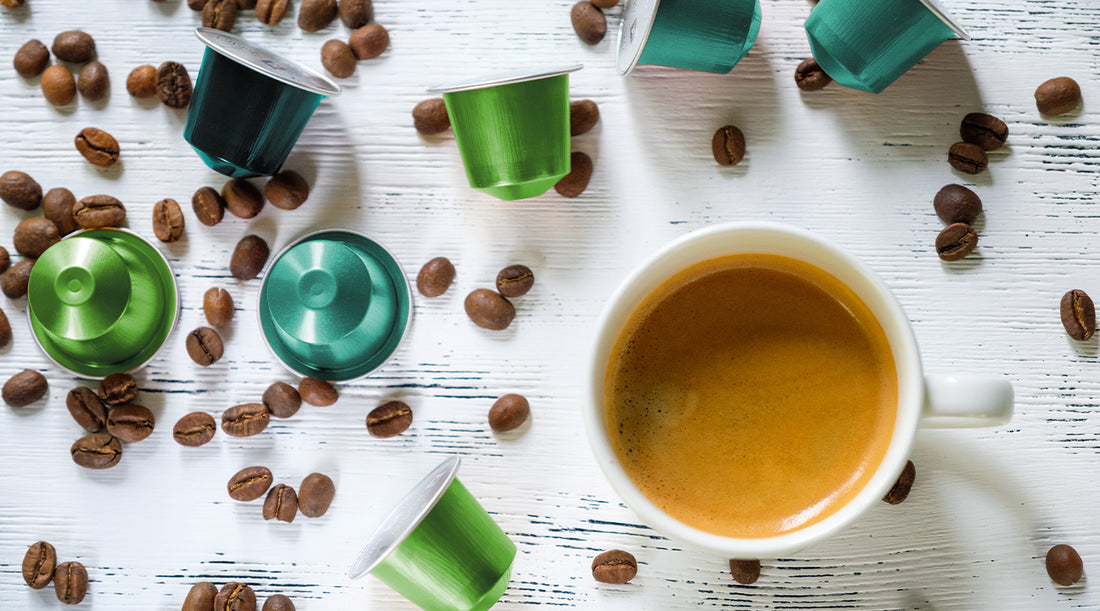
How to make your coffee capsule habit more sustainable
Share
Did you know your coffee habit could be harming the environment with long-lasting effects? According to research by Halo, a British producer of compostable coffee capsules, 39,000 beverage pods are produced globally every minute, with up to 75% of these ending up in landfill. And what’s more, every single one of these capsules can last up to 500 years! The key reason these pesky pods can hang around for so long is due to the fact they are designed to withstand the high pressures and temperatures of the coffee-making process so they aren’t easily broken down.*
So why is recycling coffee pods so difficult?
Most beverage capsules are made of a mixture of aluminium coated with plastic that needs to be separated before being recycled. This process takes time and resources most municipalities don’t have the budget for. This results in most pods ending up in landfills or incinerators.
Why don’t we stop consuming coffee pods altogether?
Turns out, while single-use pods are bad for the environment, they are by far not the worst coffee-making method for the planet. A professor from Bath University looked at all the stages of coffee production, from growing the beans to disposal of waste, assessing the impact on ecosystems, climate change, and water. Shocking results show instant coffee as the most eco-friendly option, with capsules being the runner-up, filter or drip coffee coming third, and traditional espresso having the worst environmental impact. Read the full article here.
While capsules are less harmful to the environment than other methods, the amount of waste they produce is undeniable. An article from 2016, stated nearly a third of households in the UK own an espresso pod machine, an amount that has likely increased in the last 8 years as more people work from home.
How can we manage to ethically enjoy a daily brew without compromising on taste or convenience? We have put together a few ways to best utilise the machine you already have in your home.
How to recycle coffee capsules and other beverage pod eco-friendly hacks
1. Recycling aluminium coffee pods with Zero Waste Box.
The most convenient way to recycle your pods is through our Beverage Capsule Recycling Box, which we offer in 3 sizes. This way you can enjoy your favourite brand of coffee without the environment suffering. Our boxes can accept all aluminium and plastic discs or capsules for coffee and tea from any machine or brand. Our Zero Waste Boxes include the storage, home or office collection, shipping and proper recycling of your pods. By recycling with us, you can be sure your capsules will be turned into recycled products.
2. Buy compostable capsules
Eco-conscious brands are now creating pods compatible with big brand machines that are fully compostable in your home composting bin. Coffee pods made out of compostable materials such as sugar cane, sugar beet or cornstarch can be composted at home. These cups dissolve and together with the coffee are turned into nutritious compost. When buying compostable pods double-check the product you are purchasing is compostable in domestic or home recycling as compared to commercially. Commercially compostable and industrially biodegradable coffee capsules will contaminate your home composting bin because these take a lot longer to break down. Commercially compostable and biodegradable plastic will only break down within 12 weeks and at a temperature of 60 degrees at industrial composting facilities.
3. Buy stainless steel capsules
The most sustainable option for beverage capsules would be buying reusable ones. Purchasing stainless steel or plastic refillable pods compatible with big brand machines would allow you to choose which brand of coffee while also not contributing to the single-use waste problem.
4. DIY and refill your aluminium coffee capsules at home
If you want to get creative, you can choose to refill your used pods at home. Not only is this good for the environment it also will save you quite a bit of money. You can refill your used capsules by cutting off the aluminium top layer, emptying out the old coffee grounds, rinsing the capsule, adding your favourite espresso powder and covering it with a small square of aluminium foil. Watch the process here.
5. Re-use your coffee grounds
Now that you’ve learnt all about the most sustainable ways to drink your coffee, why not go a step further and reuse your coffee grounds as well? Instead of discarding your used coffee grounds, you can use them to fertilise your garden, as a natural cleaning scrub for hard-to-clean surfaces, or to exfoliate your skin. Coffee grounds can even be used to remove stains and eliminate odours (try scrubbing your hands with coffee after chopping garlic or onion!)
Did the coffee capsule problem come as a surprise to you?
Let us know in the comments below!
